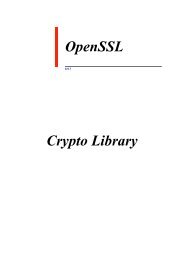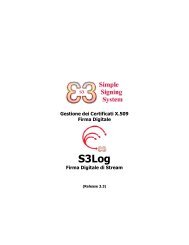Internet X.509 Public Key Infrastructure (PKI) Proxy ... - Clizio.com
Internet X.509 Public Key Infrastructure (PKI) Proxy ... - Clizio.com
Internet X.509 Public Key Infrastructure (PKI) Proxy ... - Clizio.com
You also want an ePaper? Increase the reach of your titles
YUMPU automatically turns print PDFs into web optimized ePapers that Google loves.
RFC 3820 <strong>X.509</strong> <strong>Proxy</strong> Certificate Profile June 2004identity via the PC, and can apply any ACs that bind that identity toattributes in order to determine authorization rights. AdditionallyPC with policies could be used to selectively deny the binding of ACsto a particular proxy. An AC could also be bound to a particular PCusing the subject or issuer and serial number of the proxycertificate. There would appear to be great synergies between theuse of <strong>Proxy</strong> Certificates and Attribute Certificates produced bythird party Attribute Authorities.However, the uses of Attribute Certificates that are granted by thefirst type of Attribute Authority, the end entity AA, overlapconsiderably with the uses of <strong>Proxy</strong> Certificates as described in theprevious sections. Such Attribute Certificates are generally usedfor delegation of rights from one end entity to others, which clearlyoverlaps with the stated purpose of <strong>Proxy</strong> Certificates, namely singlesign-on and delegation.5.1.2. Delegation Using Attribute CertificatesIn the motivating example in Section 2, PCs are used to delegateSteve’s identity to the various other jobs and entities that need toact on Steve’s behalf. This allows those other entities toauthenticate as if they were Steve, for example to the mass storagesystem.A solution to this example could also be cast using AttributeCertificates that are signed by Steve’s EEC, which grant to the otherentities in this example the right to perform various operations onSteve’s behalf. In this example, the reliable file transfer serviceand all the hosts involved in file transfers, the starter program,the agent, the simulation jobs, and the post-processing job wouldeach have their own EECs. Steve’s EEC would therefore issue ACs tobind each of those other EEC identities to attributes that grant thenecessary privileges allow them to, for example, access the massstorage system.However, this AC based solution to delegation has some disadvantagesas <strong>com</strong>pared to the PC based solution:* All protocols, authentication code, and identity basedauthorization services must be modified to understand ACs. Withthe PC solution, protocols (e.g., TLS) likely need nomodification, authentication code needs minimal modification(e.g., to perform PC aware path validation), and identity basedauthorization services need minimal modification (e.g., possiblyto find the EEC name and to check for any proxy policies).Tuecke, et al. Standards Track [Page 25]









